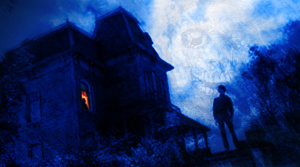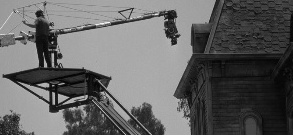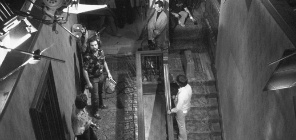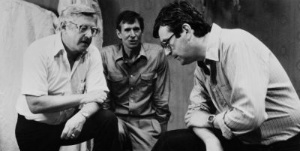
Director: Richard Franklin
Writer: Tom Holland
Starring: Anthony Perkins, Vera Miles, Meg Tilly, Robert Loggia
Rating: R (USA), 15 (UK), M (Australia)
Every sequel has a certain amount of expectation to live up to. The fanbase and familiarity that has built up around the original movie always causes both high expectations and brutal criticism when it comes to viewing the follow-up to a much loved classic. But very few filmmakers have felt the pressure that Richard Franklin faced when he decided to undertake the unthinkable and make a sequel to Psycho, perhaps the most respected and analysed movie of the last fifty years. The timing was just right, with Psycho having influenced the slasher genre perhaps it was apt that a sequel would be produced during the height of the craze. But following in the footsteps of such an auteur as Alfred Hitchcock is no mean feet, especially when the movie in question happens to have revolutionised horror cinema and introduce audiences to the archetype movie maniac, a sweet and seemingly gentle young man harbouring a deadly secret. Leatherface, Hannibal Lecter, none of them would have existed without the psycho known as Norman Bates.
As the success of the movie had laid in the blueprint of a novel by author Robert Bloch, it would make sense that the sequel would begin in the same place. Bowing to the suggestion of his agent, Bloch began work on the much-anticipated follow-up to his most renowned of works, which would continue the adventures of his twisted protagonist from the mental asylum from which he has escaped on his a Hollywood set where production has begun on a movie based on his crimes. Intended as a satire on the current trend of splatter flicks, Psycho 2 was a departure from the first book’s subtle-yet-complex structure and more into biting social satire. As a mark of respect for their treatment of his earlier work, Bloch sent Universal a copy of the manuscript, as the studio still owned the rights and would have the option of adapting the new story into another motion picture. The executives were unimpressed and asked Bloch to cease work on the novel to allow them to create a sequel which the fans could consider canon. The writer ignored their wishes and the book was eventually published in 1982 to modest success. Undeterred by the competition, Universal immediately greenlit their own follow-up which they decided would have no relation to Bloch’s work and set out to develop the film as soon as possible. In conjunction with first-time production company Oak Media Development Corporation, whom the studio had recently entered into a four-picture contract with, Universal set out to find suitable talent with which to bring back the now-iconic Norman for what they intended to be a made-for-cable venture.

Having spent the earlier part of his career helping out around sets such as Hitchcock’s Tapaz and Family Plot, Australian filmmaker Franklin had seemed like the ideal choice to follow in his footsteps. Having received a phone call from producer Bernard Schwartz, Franklin was invited in to meet with the studio to discuss potential ideas for Psycho 2, as well as the possibility of also directing. After hiring screenwriter Tom Holland, who had previously penned the popular low budget exploitation flicks The Beast Within and Class of 1984, Holland worked closely with Franklin on developing both plot and character, before Holland completed the script alone. Instead of starting the story with Norman escaping from the institution which he had been incarcerated in since the events of the first film, Franklin and Holland instead decided to have Norman paroled and released back into society, having believed to have been rehabilitated. As the script was being developed, the studio approached Anthony Perkins, whose career since Psycho had included highlights like Murder on the Orient Express and The Black Hole, to once again portray Norman. Despite initially being reluctant after being typecast in the previous movie, Perkins eventually agreed and began on various minor alternations in the script, particularly between his character and Mary Loomis, a young down-on-her-luck drifter whom he has taken under his wing.
With Holland submitting his final draft on June 25th 1982, casting was swiftly underway for the assortment of characters that would enter Norman’s life, for better or worse. The task of finding the appropriate actors fell to Jackie Burch, who would later be responsible for similar duties on an array of eighties classics (The Breakfast Club, Fright Night, Predator). Whilst the filmmakers had managed to convince Perkins to return, two of the principal stars from Psycho would be absent for different reasons. Whilst Janet Leigh had been immortalised in the infamous ‘shower scene,’ the sequence had also marked the death of her character, bringing her story to an end. Her on-screen lover, Sam Loomis, had been portrayed by John Gavin, who had retired from acting to become President Reagan’s first Ambassador to Mexico on May 7 1981. But Psycho 2 would mark the return of Vera Miles, who had played Norman’s nemesis (and Leigh’s sister), Lila Crane, who was now determined to see him locked up once again, even if it means driving him insane. Although her name would once again be missing from the credits, Virginnia Gregg would provide the creepy voice of Norman’s mother. In the role of Mary Loomis (whose name was a reference to Bloch’s first novel, in which Marion Crane’s name had originally been Mary and her lover was called Loomis), the filmmakers eventually settled on Meg Tilly, a beautiful half American-half Chinese actress whose previous work included Fame and the obscure horror One Dark Night (directed by Tom McLoughlin, who would later helm Friday the 13th Part 6: Jason Lives).

One of the more important aspects of the movie, aside from the presence of Perkins, was the famous Bates Motel and the old house that looked over it. The mansion was thankfully still standing on the Universal lot, although the studio were forced to recreate the motel from scratch. Basing his designs on the various photographs of the original movie, production designer John Corso began to build the motel piece by piece, carefully making sure all the measurements were identical in order to create a perfect replica. But the background and the unused portions of the building were matte paintings designed by Albert Whitlock (also responsible for the exterior of the diner where Norman worked), who had worked for Hitchcock himself on The 39 Steps, The Lady Vanishes, The Man Who Knew Too Much and many more. Jennifer Pollito, whose role as set dresser involved recreating the various props from the Mates home (including the stuffed birds), was so successful that a surprise visit from his predecessor, George Milo, was greeted with immense approval.
Filming commenced on Stage 24 of Universal Studios, California, on June 30 1982, with the very first shot being of Norman walking up the stairs of his old home, perfectly recreated by the production team. The cinematography, which had been intended to reference the original’s black and white whilst also moving more towards the neon-noir look that the Coen Brothers had used in their debut Blood Simple the same year, was handled by Dean Cundey, who had perfected the likes of the stedicam during his collaboration with John Carpenter on Halloween in 1978. The positive atmosphere on set quickly turned sour when Tilly, oblivious to the legacy that Psycho had left, casually asked a member of the crew why Perkins was receiving so much attention. The overly sensitive actor became furious and demanded that the actress be replaced, despite the fact that much of her footage had already been filmed. The shoot itself, which had been budgeted at approximately $5m, would last thirty-two days, with the other principal location being Courthouse Square, also located at Universal, which would later be used in the likes of Gremlins and Back to the Future.

The filmmakers remained conscious throughout the shoot that they were making a sequel to a Hitchcock classic and so they tried to avoid using excessive blood or pointless nudity like many of the other slashers of the year (such as Sleepaway Camp). Instead opting for the subtle atmosphere of the original, Franklin’s main focus was on the relationship between Norman and Mary, which Perkins had tried to expand on with the inclusion of a scene in which his guest enjoys a sandwich whilst they get to know each other (similar to the sequence with Marion Crane in Psycho). This was as Perkins did not want the character to simply be reduced to a slasher-style boogeyman. Despite their differences, Perkins and Tilly (sister of Bride of Chucky star Jennifer Tilly) displayed an on-screen chemistry which managed to bring out the best in Holland’s screenplay, which had tried to humanise Norman and show some kind of repentance for his sins. The mother was also wisely left out of sight, once again only show as shadows or silhouettes or, during the climax, where he once again dons her dress and wig as he slips back into insanity.
The production finally came to a finish in August 1982, where it was then relocated to the editing room, under the watchful eye of Andrew London. Having been a friend of the director’s during their time at the University of Southern California in the late sixties, Franklin would give London his first big break with Psycho 2 after gaining the approval of Universal‘s Vice President Verna Fields, who had worked himself as an editor on American Graffiti, The Sugarland Express and Jaws. London would later work on such blockbusters as Rambo 3. With Gerry Goldsmith completing his score (as the first film’s composer, Bernard Herrmann, had sadly passed away almost a decade earlier, Psycho 2 was finally released on 3 June 1983 and was greeted with mostly positive reviews, earning a surprising $8,310,244 on its opening weekend. Some of the more devoted fans of Hitchcock’s movie were more critical when comparing the two, with renowned journalist Roger Ebert stating that, ‘If you’ve seen Psycho a dozen times and can recite the shots in the shower scene by heart, Psycho 2 is just not going to do it for you.’ Regardless, the movie would eventually make approximately $32m during its American theatrical run, guaranteeing that Norman Bates would return again.


2 Responses to A BOY’S BEST FRIEND pt.2 – Psycho 2 (1983)